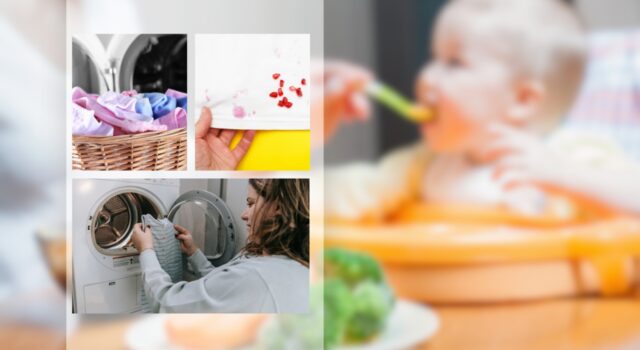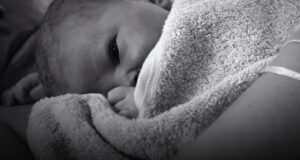Breastfeeding is a beautiful and intimate experience that allows mothers to nourish their infants while fostering a unique bond. However, it is also a path with challenges, from the initial learning curve to the ongoing commitment required.
Among these challenges, one that often goes unmentioned but is nevertheless a part of the breastfeeding experience is dealing with common stains.
These stains can mar clothing, breast pads, nursing bras, and even baby attire. It’s not uncommon for breastfeeding moms to face the unexpected consequences of leaking breast milk, baby spit-up, and the occasional mishap during feeding sessions.
However, this is a problem because you cannot rely on the nearest laundry service provider like Liox.
Baby clothes need special care and attention. Only a home laundry service is possible, as you can guide and provide specific instructions to the staff.
So, mothers, let’s dive into stain management.
Breast Milk Stains

Breast milk stains occur due to their composition, leaving greasy marks and proteins that bind to fabric fibers. When breast milk dries on clothing, removing it can become even more challenging, often leaving behind unsightly residue.
The key to successfully dealing with breast milk stains is prompt action. When you notice a spill or leakage, gently blot the affected area with an absorbent cloth or paper towel. Avoid rubbing, as this can push the milk deeper into the fabric.
You can soak the stained item in cold water for at least 30 minutes to help loosen the stain. After pre-treating, wash the stained item with a mild detergent in cold water. Avoid using hot water as it can set the stain.
Breast milk stains are avoidable. You can:
- Invest in quality breast pads or nursing bras with good absorption and coverage.
- Change breast pads frequently, especially if they become saturated.
- Consider using reusable breast pads that are made of absorbent materials.
- Wear clothing with multiple layers or patterns to help conceal any accidental leaks.
- Use nursing covers or blankets during breastfeeding to catch any spills.
Baby Spit-Up Stains
Baby spit-up is a frequent occurrence during the early months of infancy. It happens for various reasons, including immature digestive systems and the tendency for babies to overfeed or swallow air while nursing.
As a result, it is not surprising that spit-up stains are common for parents. Spit-up often contains milk or formula, which can leave behind noticeable stains due to its protein content and sometimes acidic nature.
When dealing with spit-up stains, you have to:
Blot and scrape:
As soon as you notice spit-up on your clothing, use a clean cloth or paper towel to blot the area gently. Avoid rubbing, as this can spread the stain. For any solid residue, carefully scrape it off with a dull edge, such as a spoon or butter knife.
Use cold water:
After blotting, rinse the stained area with cold water. Cold water helps to prevent the proteins in spit-up from binding tightly to the fabric fibers. Continue to rinse until you’ve removed as much of the stain as possible.
Sometimes, despite quick action, spit-up stains can be stubborn. In such cases, try these stain-removal methods:
- Applying vinegar and baking soda: Create a paste by mixing equal parts of white vinegar and baking soda. Gently rub this paste onto the stain, then let it sit for about 15 to 30 minutes. Rinse the area with cold water and launder as usual. This method can help neutralize any remaining acidic components in the spit-up.
- Washing with enzyme-based detergent: Apply a small amount of the detergent to the stain and let it sit for a few minutes before washing the garment in cold water.

But, prevention is the best way. You can:
- Burp your baby: Frequent burping during and after feedings can help reduce the likelihood of spit-up.
- Use burp cloths: Place a burp cloth or cloth diaper over your shoulder when holding your baby for feedings. This can catch any unexpected spit-up.
- Feed in an upright position: Keep your baby upright while feeding to minimize the chances of excess air intake.
- Avoid overfeeding: Pay attention to your baby’s cues and feed in smaller, more frequent sessions to reduce the chances of overfeeding and spit-up.
Baby Food Stains

Feeding your baby solid foods is an exciting milestone, but it can also be messy. Spills and splatters are inevitable as your little one explores new flavors and textures.
Baby food stains are often the result of purées and mashes made from fruits, vegetables, cereals, grains, and protein-based foods. These stains can be especially challenging because they contain various ingredients that can adhere to fabric.
When spills and splashes occur, you have to:
- Wipe: Use a clean cloth or paper towel to gently wipe away as much of the baby food as possible. Be careful not to rub it further into the fabric.
- Scrape: If there’s any solid residue, gently scrape it off the fabric using the edge of a spoon or a dull knife. Again, avoid pressing too hard to prevent spreading the stain.
Preventing baby food stains might be impossible for you, but you can avoid them by:
- Use bibs: Invest in bibs with a catch-all pocket to protect your baby’s clothing from food spills.
- Choose feeding-friendly clothing: Opt for easy-to-clean, stain-resistant fabrics for you and your baby.
Motherhood: Baby Stain Management

As a breastfeeding mom, you have embarked on an incredible journey of nurturing and caring for your baby. We have seen that breast milk, baby spit-up, and baby food stains can quickly become a part of your daily life.
While stains may momentarily disrupt your day, remember they are only small blips of the joy in motherhood. That’s why understanding why these stains occur and how to remove them effectively is essential for mothers.









